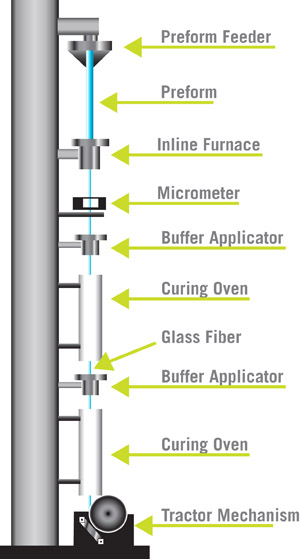Many People ask how fiber optics are made. You can’t just use “regular” glass. If you were to make optical fiber from ordinary window glass, the light that you shine through it would have a difficult time traveling more than a few kilometers, let alone the distances necessary for long distance transmission. That’s because ordinary glass contains distortions, discolorations and other impurities that would quickly absorb, reflect, or otherwise disperse light long before it could travel any great distance.
In contrast, because optical fiber is actually made from very pure glass, the light traverses great distances largely unimpeded by impurities and distortions.
Fiber Optic Cable – Light How it Works
To transmit light effectively, fiber optic cable must contain glass of the highest purity. The process of making glass with this level of purity is very demanding, requiring careful control over the materials and processes involved. Yet, the fundamental concept is simple. Essentially, optical fiber is made from drawing molten fiber from a heated glass blank or “preform.” The following provides a more detailed explanation of the three basic steps involved in making optical fiber.
Step #1
Create the Fiber Optic Preform
A preform is a cylindrical glass blank that provides the source material from which the glass fiber will be drawn in a single, continuous strand.
Making a preform involves a chemical process known as Modified Chemical Vapor Deposition (MCVD). This process involves bubbling oxygen through various chemical solutions including germanium chloride (GeC14) and silicon chloride (SiC14).
The bubbling chemicals produce gas that is directed into a hollow, rotating tube made of synthetic silica or quartz. A torch is moved up and down the rotating tube, resulting in very high temperatures that cause the gas to react with oxygen to form silicon dioxide (Si02) and germanium dioxide (Ge02). These two chemicals adhere to the inside of the rotating tube where they fuse together to form extremely pure glass.
Creating the preform takes several hours, after which additional time is required for the glass blank to cool. Once cooled, the glass is tested to ensure that it meets quality standards, especially in terms of index of refraction.
Step #2
Draw Optical Fiber from the Preform
In this step, the finished glass preform is installed at the top of a tower which supports various devices used in the fiber drawing process.
The process begins by lowering one end of the preform into an in-line furnace that produces heat in a range of 3,400 to 4,000 degrees Fahrenheit. As the lower end of the preform begins to melt, it forms a molten glob that is pulled downward by gravity. Trailing behind the glob is a thin strand of glass that cools and solidifies quickly.
The equipment operator threads this glass strand through the remainder of the devices on the tower, which include a number of buffer coating applicators and ultraviolet curing ovens. Finally, the operator connects the fiber to a tractor mechanism.
The tractor device pulls the glass strand from the preform at a rate of 33 to 66 feet per second. The actual speed at which the tractor pulls the strand is dependent upon the feedback information the device receives from a laser micrometer that continually measures the fiber’s diameter.
At the end of the run, the completed fiber is wound onto a spool.
Step # 3
Test the Fiber Optics
The completed optical fiber must undergo a number of tests to determine the quality of the finished product. The following are a few of the assessments involved:
• Refractive index profile
• Fiber geometry inspection, including core, cladding and coating
• Tensile strength • Bandwidth capacity
• Attenuation at different wavelengths
• Chromatic dispersion
• Operating temperature and humidity range
Quality Control in Optical Fiber Production
Various factors influence the quality and purity of the optical fiber produced. These include: Chemical Composition – Achieving optimal ratios of the various chemicals used to create the preform is important for achieving glass purity. This mixture of chemicals also determines the optical properties of the fiber that will be produced from the preform, including coefficient of expansion, index of refraction, and so forth. Gas Monitoring – It is crucial that the gas composition and rate of flow be monitored throughout the process of creating the preform. It is also important that any valves, tubes and pipes that come into contact with the gas be made of corrosion-resistant materials.
Heat and Rotation – The hollow cylinder that is used to create the preform must be heated at the proper temperature and continually rotated to enable the chemicals to be deposited evenly.



